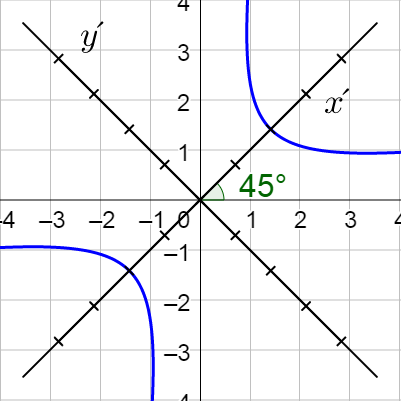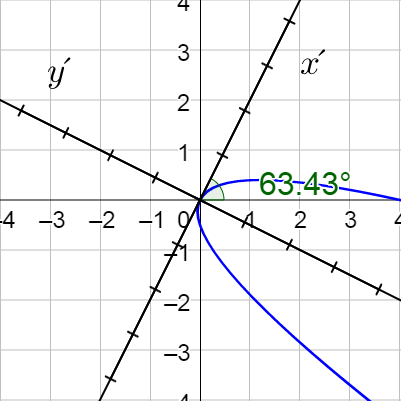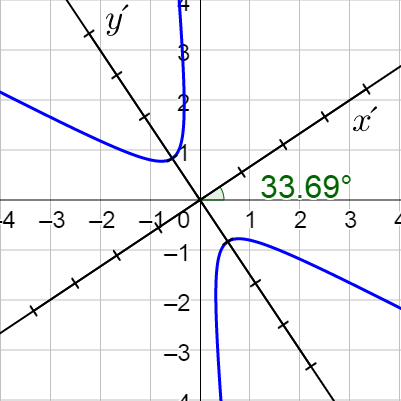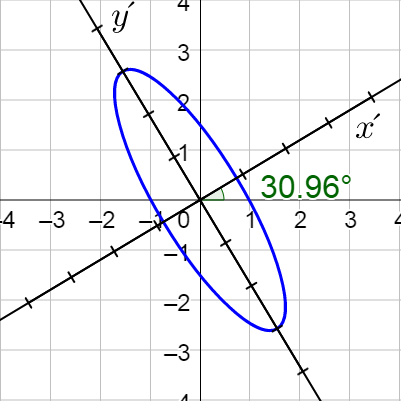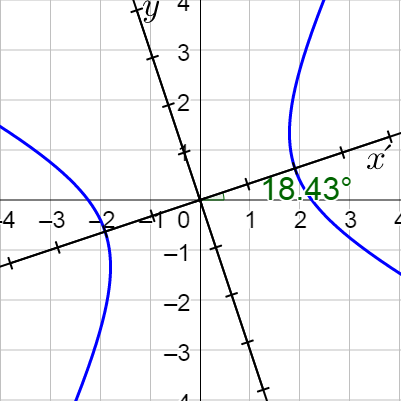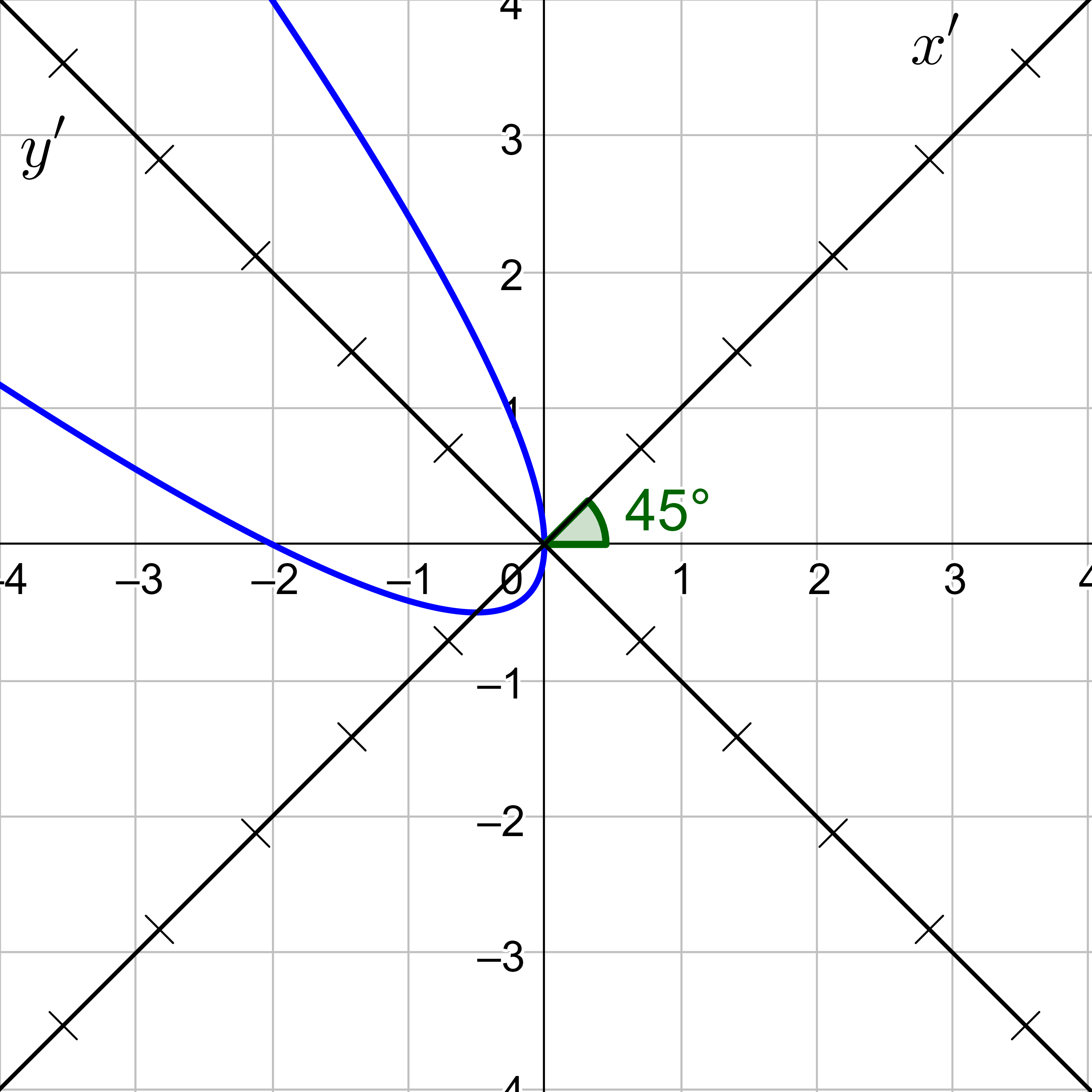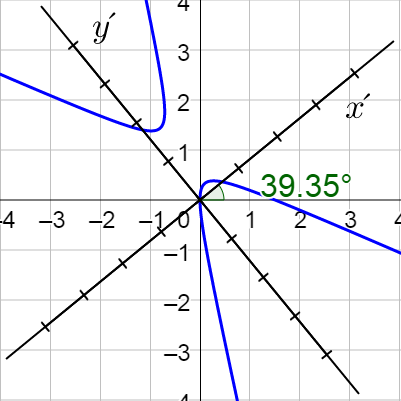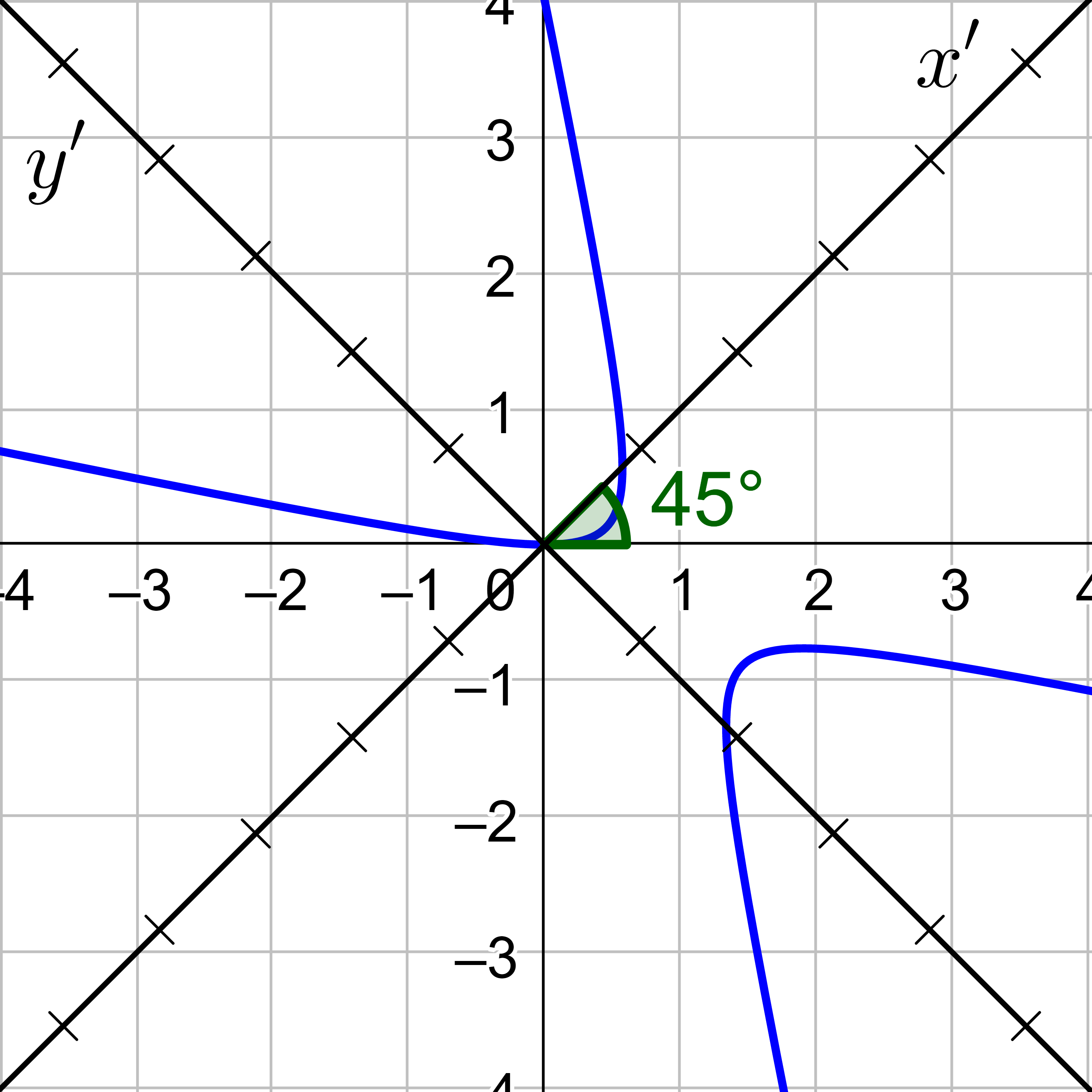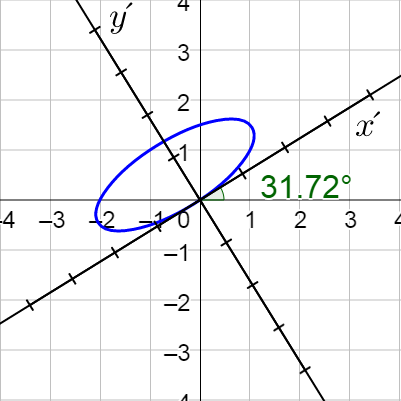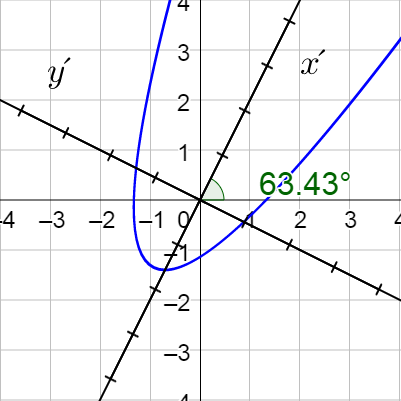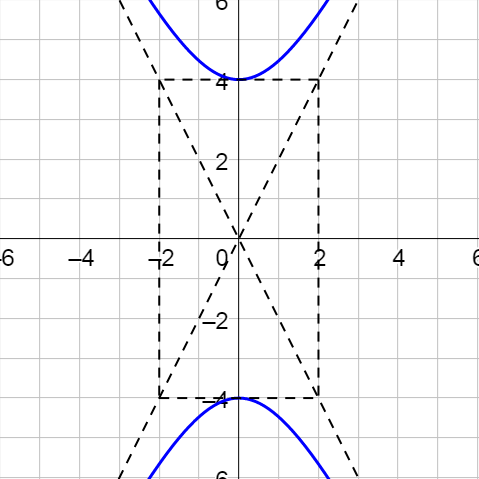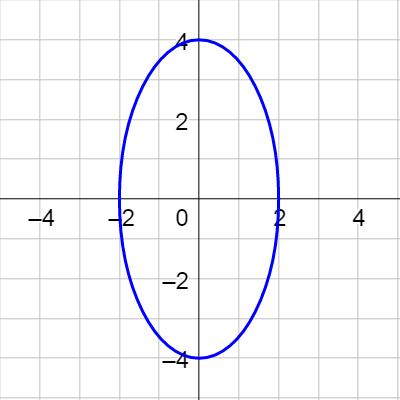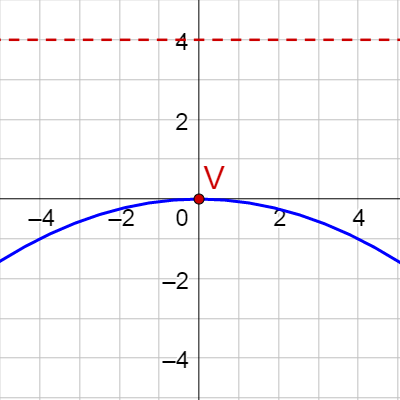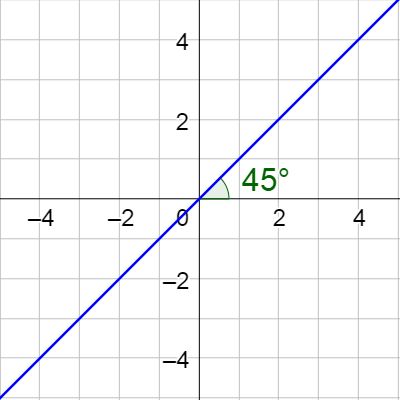Precalculus by Richard Wright
Precalculus by Richard Wright
Jesus knew their thoughts and said to them, “Every kingdom divided against itself will be ruined, and every city or household divided against itself will not stand.” Matthew 12:25 NIV
Summary: In this section, you will:
SDA NAD Content Standards (2018): PC.6.7
Note: This assignment is long and should take two days.
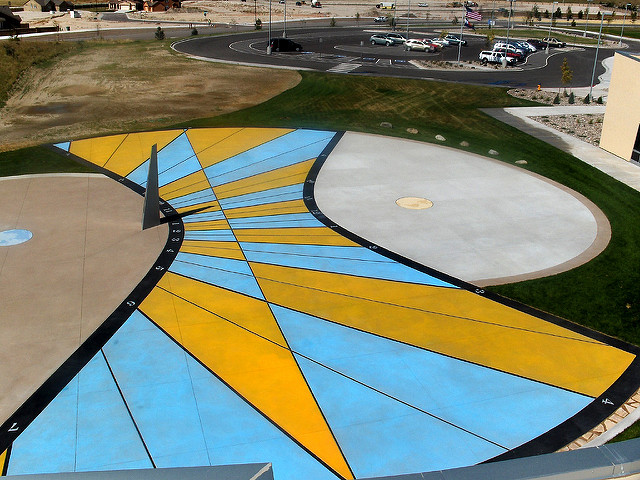
The declination line on the sundial in Figure 1 is not horizontal or vertical. It is rotated. This lesson will explore rotated conics and their equations.
All the conics in the previous lessons were in the form Ax2 + Cy2 + Dx + Ey + F = 0. All these conics are either horizontal or vertical. Conics that are not horizontal or vertical require using the missing B term. The general form of conics becomes Ax2 + Bxy + Cy2 + Dx + Ey + F = 0.
The Bxy term prevents completing the square to write the conics in standard form. In order to graph these rotated conics or write them in standard form, the Bxy term needs to be eliminated. Then write the equation in the form A′(x′)2 + C′(y′)2 + D′x′ + E′y′ + F′ = 0 by rotating the coordinate axes counterclockwise through the angle θ, where
$$\cot 2θ = \frac{A - C}{B}$$
where 0 < 2θ < π and 0 < θ < \(\frac{π}{2}\).
The coefficients of the new equation are obtained by making the substitutions
$$\begin{alignat}{2}x &= x′ \cos θ &- y′\sin θ\\ y &= x′ \sin θ &+ y′ \cos θ\end{alignat}$$
The following quantities to not change during rotations.
The invariants can be used to classify conics without eliminating the Bxy term. B2 – 4AC is the discriminant and identifies the type of conic.
If the conic is in the form Ax2 + Bxy + Cy2 + Dx + Ey + F = 0 and B ≠ 0, then conic can be classified by
Given a conic written as Ax2 + Bxy + Cy2 + Dx + Ey + F = 0 where B ≠ 0
Find the angle of rotation using
$$\cot 2θ = \frac{A - C}{B}$$
where 0 < θ < \(\frac{π}{2}\).
Find sin θ and cos θ.
If θ is a special angle, evaluate sin θ and cos θ directly.
If θ is not a special angle,
Use the half-angle formulas to find sin θ and cos θ.
$$\sin θ = \sqrt{\frac{1 - \cos 2θ}{2}} \text{ and } \cos θ = \sqrt{\frac{1 + \cos 2θ}{2}}$$
Find the substitutions for x and y using
$$\begin{alignat}{2}x &= x′ \cos θ &&- y′ \sin θ\\y &= x′ \sin θ &&+ y′ \cos θ\end{alignat}$$
Classify \(xy = \frac{1}{2}\) and then write it in standard form.
Solution
Compare \(xy = \frac{1}{2}\) to Ax2 + Bxy + Cy2 + Dx + Ey + F = 0 and find that A = 0, B = 1, and C = 0.
Classify the conic by using the discriminant.
B2 − 4AC
12 – 4(0)(0) = 1
Since B2 − 4AC > 0, it is a hyperbola.
Write it in standard form by first finding the angle of rotation.
$$\cot 2θ = \frac{A - C}{B} = \frac{0}{1} = 0$$
$$2θ = \frac{π}{2}$$
$$θ = \frac{π}{4}$$
Find the substitutions for x and y.
$$\begin{alignat}{2}x &= x′ \cos \frac{π}{4} &- y′ \sin \frac{π}{4}\\ y &= x′ \sin \frac{π}{4} &+ y′ \cos \frac {π}{4}\end{alignat}$$
$$\begin{alignat}{2}x &= \frac{\sqrt{2}}{2} x′ &- \frac{\sqrt{2}}{2} y′\\ y &= \frac{\sqrt{2}}{2} x′ &+ \frac{\sqrt{2}}{2} y′\end{alignat}$$
Substitute these into the original equation and simplify.
$$xy = \frac{1}{2}$$
$$\left(\frac{\sqrt{2}}{2} x′ - \frac{\sqrt{2}}{2} y′\right)\left(\frac{\sqrt{2}}{2} x′ + \frac{\sqrt{2}}{2} y′\right) = \frac{1}{2}$$
$$\frac{1}{2} (x′)^2 - \frac{1}{2} (x′y′) + \frac{1}{2} (x′y′) - \frac{1}{2} (y′)^2 = \frac{1}{2}$$
$$(x′)^2 - (y′)^2 = 1$$
From the equation, this conic is a hyperbola.
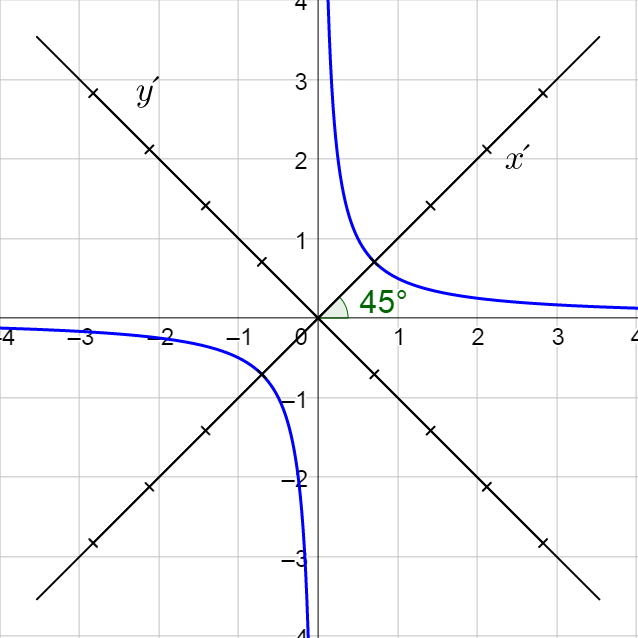
Classify xy − 2 = 0 and then write the conic in standard form.
Answer
Hyperbola; \(\frac{(x′)^2}{4}-\frac{(y′)^2}{4} = 1\)
Classify \(3x^2 + \sqrt{3}xy + 2y^2 - 6 = 0\) and then sketch the graph.
Solution
Compare \(3x^2 + \sqrt{3}xy + 2y^2 - 6 = 0\) to Ax2 + Bxy + Cy2 + Dx + Ey + F = 0 and find that A = 3, B = \(\sqrt{3}\), and C = 2.
Classify the conic by using the discriminant.
B2 − 4AC
$$\left(\sqrt{3}\right)^2 - 4(3)(2) = -21$$
Since B2 − 4AC < 0, it is a ellipse.
Write it in standard form by first finding the angle of rotation.
$$\cot 2θ = \frac{A - C}{B} = \frac{3 - 2}{\sqrt{3}} = \frac{1}{\sqrt{3}}$$
$$2θ = \frac{π}{3}$$
$$θ = \frac{π}{6}$$
Find the substitutions for x and y.
$$\begin{alignat}{2}x &= x′ \cos \frac{π}{6} &&- y′ \sin \frac{π}{6}\\ y &= x′ \sin \frac{π}{6} &&+ y′ \cos \frac{π}{6}\end{alignat}$$
$$\begin{alignat}{2}x &= \frac{\sqrt{3}}{2} x′ &&- \frac{1}{2} y′\\ y &= \frac{1}{2} x′ &&+ \frac{\sqrt{3}}{2} y′\end{alignat}$$
Substitute these into the original equation and simplify.
\(3\left(\frac{\sqrt{3}}{2} x′ - \frac{1}{2} y′\right)^2 + \sqrt{3} \left(\frac{\sqrt{3}}{2} x′ - \frac{1}{2} y′\right)\left(\frac{1}{2} x′ + \frac{\sqrt{3}}{2} y′\right) + 2\left(\frac{1}{2} x′ + \frac{\sqrt{3}}{2} y′\right)^2 - 6 = 0\)
\(3\left(\frac{3}{4} (x′)^2 - \frac{\sqrt{3}}{2} x′y′ + \frac{1}{4} (y′)^2\right) + \sqrt{3}\left(\frac{\sqrt{3}}{4} (x′)^2 + \frac{1}{2} x′y′ - \frac{\sqrt{3}}{4} (y′)^2\right) + 2\left(\frac{1}{4} (x′)^2 + \frac{\sqrt{3}}{2} x′y′ + \frac{3}{4} (y′)^2\right) - 6 = 0\)
\(\frac{9}{4} (x′)^2 - \frac{3\sqrt{3}}{2} x′y′ + \frac{3}{4} (y′)^2 + \frac{3}{4} (x′)^2 + \frac{\sqrt{3}}{2} x′y′ - \frac{3}{4} (y′)^2 + \frac{1}{2} (x′)^2 + \sqrt{3} x′y′ + \frac{3}{2} (y′)^2 - 6 = 0\)
$$\frac{7}{2} (x′)^2 + \frac{3}{2} (y′)^2 = 6$$
Divide by 6 to write to make the equation equal 1.
$$\frac{(x′)^2}{^{12}/_7} + \frac{(y′)^2}{4} = 1$$
Thus it is a vertical ellipse with a = 2 and b = \(\frac{2\sqrt{21}}{7}\) and center (0, 0).
Draw the rotated axis, then move a = 2 along the rotated y-axis and b = \(\frac{2\sqrt{21}}{7}\) along the rotated x-axis.
Connect the points with a nice ellipse.
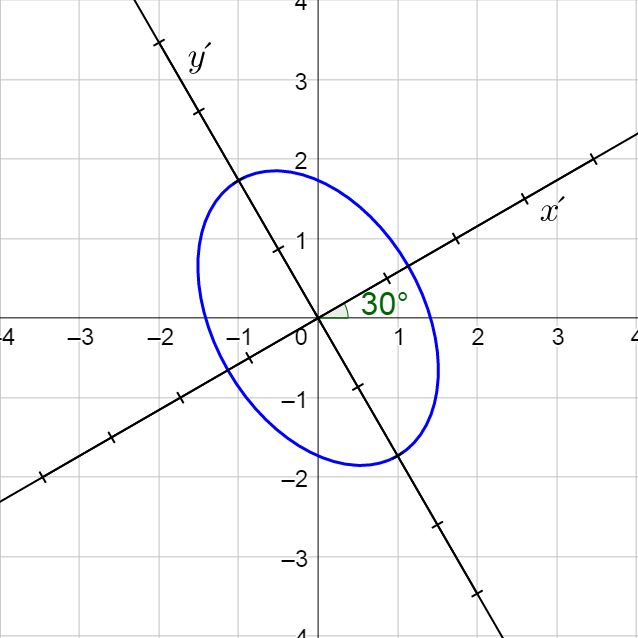
Classify 5x2 − 6xy + 5y2 − 32 = 0 and then sketch its graph.
Answer
Ellipse; \(\frac{(x′)^2}{16} + \frac{(y′)^2}{4} = 1\); 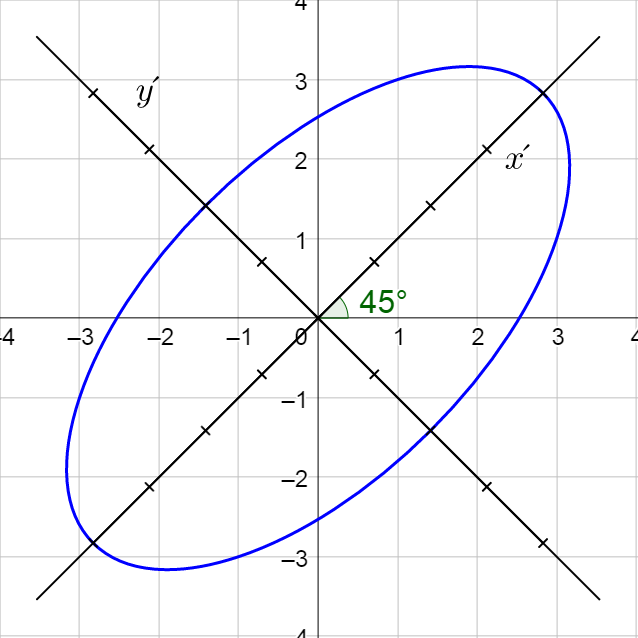
Classify \(3x^2 - 2\sqrt{3} xy + y^2 - 16x - 16\sqrt{3} y = 0\) and then sketch the graph.
Solution
Compare \(3x^2 - 2\sqrt{3} xy + y^2 - 16x - 16\sqrt{3} y = 0\) to Ax2 + Bxy + Cy2 + Dx + Ey + F = 0 and find that A = 3, B = \(-2\sqrt{3}\), and C = 1.
Classify the conic by using the discriminant.
B2 − 4AC
$$\left(-2\sqrt{3}\right)^2 – 4(3)(1) = 0$$
Since B2 − 4AC = 0, it is a parabola.
Write it in standard form by first finding the angle of rotation.
$$\cot 2θ = \frac{A - C}{B} = \frac{3 - 1}{-2\sqrt{3}} = -\frac{1}{\sqrt{3}}$$
$$2θ = \frac{2π}{3}$$
$$θ = \frac{π}{3}$$
Find the substitutions for x and y.
$$\begin{alignat}{2}x &= x′ \cos \frac{π}{3} &&- y′ \sin \frac{π}{3}\\ y &= x′ \sin \frac{π}{3} &&+ y′ \cos \frac{π}{3}\end{alignat}$$
$$\begin{alignat}{2}x &= \frac{1}{2} x′ &&- \frac{\sqrt{3}}{2} y′\\ y &= \frac{\sqrt{3}}{2} x′ &&+ \frac{1}{2} y′\end{alignat}$$
Substitute these into the original equation and simplify.
\(3\left(\frac{1}{2} x′ - \frac{\sqrt{3}}{2} y′\right)^2 - 2\sqrt{3}\left(\frac{1}{2} x′ - \frac{\sqrt{3}}{2} y′\right)\left(\frac{\sqrt{3}}{2} x′ + \frac{1}{2} y′\right) + \left(\frac{\sqrt{3}}{2} x′ + \frac{1}{2} y′\right)^2 - 16\left(\frac{1}{2} x′ - \frac{\sqrt{3}}{2} y′\right) - 16\sqrt{3} \left(\frac{\sqrt{3}}{2} x′ + \frac{1}{2} y′\right) = 0\)
\(3\left(\frac{1}{4} (x′)^2 - \frac{\sqrt{3}}{2} x′y′ + \frac{3}{4} (y′)^2\right) - 2\sqrt{3} \left(\frac{\sqrt{3}}{4} (x′)^2 - \frac{1}{2} x′y′ - \frac{\sqrt{3}}{4} (y′)^2\right) + \left(\frac{3}{4} (x′)^2 + \frac{\sqrt{3}}{2} x′y′ + \frac{1}{4} (y′)^2\right) - 16\left(\frac{1}{2} x′ - \frac{\sqrt{3}}{2} y′\right) - 16\sqrt{3} \left(\frac{\sqrt{3}}{2} x′ + \frac{1}{2} y′\right) = 0\)
\(\frac{3}{4} (x′)^2 - \frac{3\sqrt{3}}{2} x′y′ + \frac{9}{4} (y′)^2 - \frac{3}{2} (x′)^2 + \sqrt{3} x′y′ + \frac{3}{2} (y′)^2 + \frac{3}{4} (x′)^2 + \frac{\sqrt{3}}{2} x′y′ + \frac{1}{4} (y′)^2 - 8 x′ + 8\sqrt{3} y′ - 24 x′ - 8\sqrt{3} y′ = 0\)
$$4 (y′)^2 - 32 x′ = 0$$
$$(y′)^2 = 8x′$$
This is a horizontal parabola. Graph it by drawing the rotated axes and plotting points.
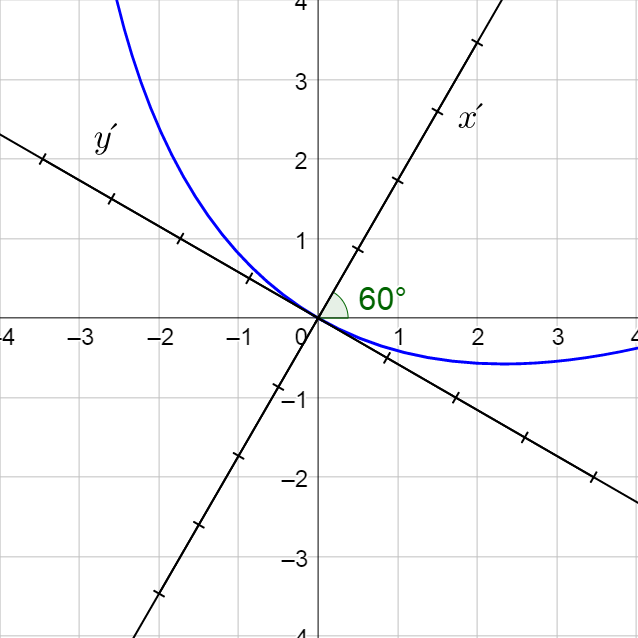
Classify \(3x^2 + 2\sqrt{3}xy + y^2 + 8x - 8\sqrt{3}y = 0\) and then sketch the graph.
Answer
Parabola; (x′)2 = 4y′; 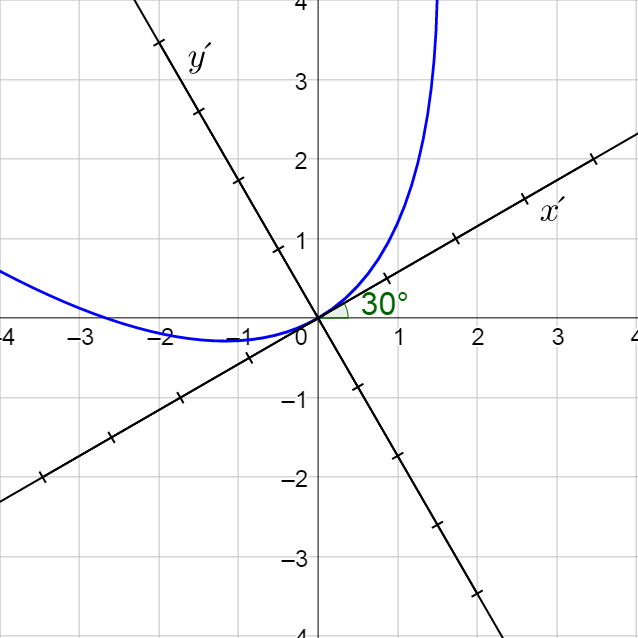
Classify 5x2 + 4xy + 2y2 − 16 = 0 and then sketch the graph.
Solution
Compare 5x2 + 4xy + 2y2 − 16 = 0 to Ax2 + Bxy + Cy2 + Dx + Ey + F = 0 and find that A = 5, B = 4, and C = 2.
Classify the conic by using the discriminant.
B2 − 4AC
42 – 4(5)(2) = −24
Since B2 − 4AC < 0, it is a ellipse.
Write it in standard form by first finding the angle of rotation.
$$\cot 2θ = \frac{A - C}{B} = \frac{5 - 2}{4} = \frac{3}{4}$$
$$2θ = 53.13°$$
$$θ = 26.57°$$
This is not on the unit circle, so it will not produce a special angle. So the substitutions for x and y are usually found by using half-angle formulas to find sin θ and cos θ.
Find cot 2θ.
$$\cot 2θ = \frac{3}{4}$$
Reciprocal to find tan 2θ.
$$\tan 2θ = \frac{4}{3}$$
Use 1 + tan2 u = sec2 u to find sec 2θ. (If tan 2θ < 0, then sec 2θ < 0.)
$$1 + \tan^2 2θ = \sec^2 2θ$$
$$1 + \left(\frac{4}{3}\right)^2 = \sec^2 2θ$$
$$1 + \frac{16}{9} = \sec^2 2θ$$
$$\frac{25}{9} = \sec^2 2θ$$
$$\sec 2θ = \frac{5}{3}$$
Reciprocal to find cos 2θ.
$$\cos 2θ = \frac{3}{5}$$
Use the half-angle formulas to find sin θ and cos θ.
$$\sin θ = \sqrt{\frac{1 - \cos 2θ}{2}} \text{ and } \cos θ = \sqrt{\frac{1 + \cos 2θ}{2}}$$
$$\sin θ = \sqrt{\frac{1 - ^3/_5}{2}} \text{ and } \cos θ = \sqrt{\frac{1 + ^3/_5}{2}}$$
$$\sin θ = \sqrt{\frac{^2/_5}{2}} \text{ and } \cos θ = \sqrt{\frac{^8/_5}{2}}$$
$$\sin θ = \sqrt{\frac{1}{5}} \text{ and } \cos θ = \sqrt{\frac{4}{5}}$$
$$\sin θ = \frac{\sqrt{5}}{5} \text{ and } \cos θ = \frac{2\sqrt{5}}{5}$$
Substitute these into the original equation and simplify.
\(5\left(\frac{2\sqrt{5}}{5} x′ - \frac{\sqrt{5}}{5} y′\right)^2 + 4 \left(\frac{2\sqrt{5}}{5} x′ - \frac{\sqrt{5}}{5} y′\right)\left(\frac{\sqrt{5}}{5} x′ + \frac{2\sqrt{5}}{5} y′\right) + 2\left(\frac{\sqrt{5}}{5} x′ + \frac{2\sqrt{5}}{5} y′\right)^2 - 16 = 0\)
\(5\left(\frac{4}{5} (x′)^2 - \frac{4}{5} x′y′ + \frac{1}{5} (y′)^2\right) + 4\left(\frac{2}{5} (x′)^2 + \frac{3}{5} x′y′ - \frac{2}{5} (y′)^2\right) + 2\left(\frac{1}{5} (x′)^2 + \frac{4}{5} x′y′ + \frac{4}{5} (y′)^2\right) - 16 = 0\)
\(4(x′)^2 - 4x′y′ + (y′)^2 + \frac{8}{5} (x′)^2 + \frac{12}{5} x′y′ - \frac{8}{5} (y′)^2 + \frac{2}{5} (x′)^2 + \frac{8}{5} x′y′ + \frac{8}{5} (y′)^2 - 16 = 0\)
$$6(x′)^2 + (y′)^2 = 16$$
Divide by 16 to write to make the equation equal 1.
$$\frac{3(x′)^2}{8} + \frac{(y′)^2}{16} = 1$$
Thus, it is a vertical ellipse with a = 4 and b = \(\frac{2\sqrt{6}}{3}\) and center (0, 0).
Draw the rotated axis, then move a = 4 along the rotated y-axis and b = \(\frac{2\sqrt{6}}{3}\) along the rotated x-axis.
Connect the points with a nice ellipse.
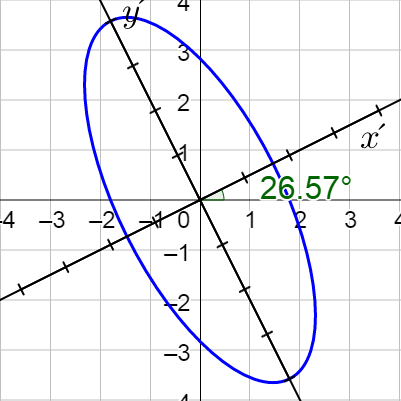
Classify 7x2 + 5xy – 7y2 – 30 = 0 and the sketch its graph.
Answer
Hyperbola; 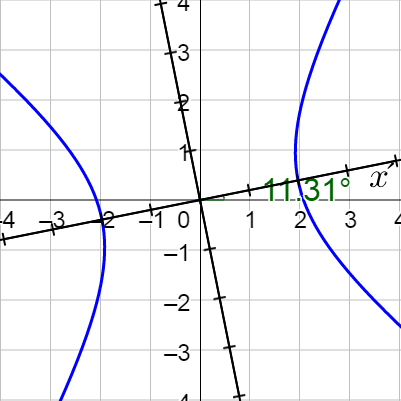
For each of the following, classify the graph, use the quadratic formula to solve for y, and use a graphing utility to graph the equation.
Solution
Classify the graph using the discriminant. B2 – 4AC = 62 – 4(1)(−2) = 44 > 0, so it is a hyperbola.
To solve for y, rearrange terms in powers of y and factor.
x2 + 6xy − 2y2 + 3x = 0
−2y2 + 6xy + (x2 + 3x) = 0
Now fill in the quadratic formula: \(y = \frac{-b ± \sqrt{b^2 - 4ac}}{2a}\).
$$y = \frac{-6x ± \sqrt{(6x)^2 - 4(-2)(x^2 + 3x)}}{2(3)}$$
Because of the ± sign, you will have to input two equations, one with + and one with −, to make the graph. Notice that the graph is shifted and (0, 0) is not the center.
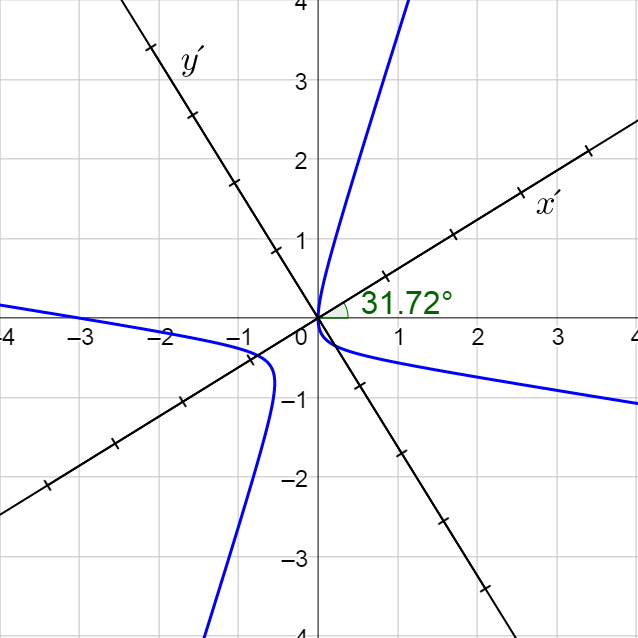
Classify the graph using the discriminant. B2 – 4AC = (−2)2 – 4(2)(1)= −4 < 0, so it is an ellipse.
To solve for y, rearrange the terms in powers of y and factor.
2x2 − 2xy + y2 − 2y = 0
y2 + (−2xy − 2y) + 2x2 = 0
y2 + (−2x − 2)y + 2x2 = 0
Now fill in the quadratic formula: \(y = \frac{-b ± \sqrt{b^2 - 4ac}}{2a}\).
$$y = \frac{-(-2x - 2) ± \sqrt{(-2x - 2)^2 - 4(1)(2x^2)}}{2(1)}$$
Because of the ± sign, you will have to input two equations, one with + and one with −, to make the graph. Notice that the graph is shifted and (0, 0) is not the center.
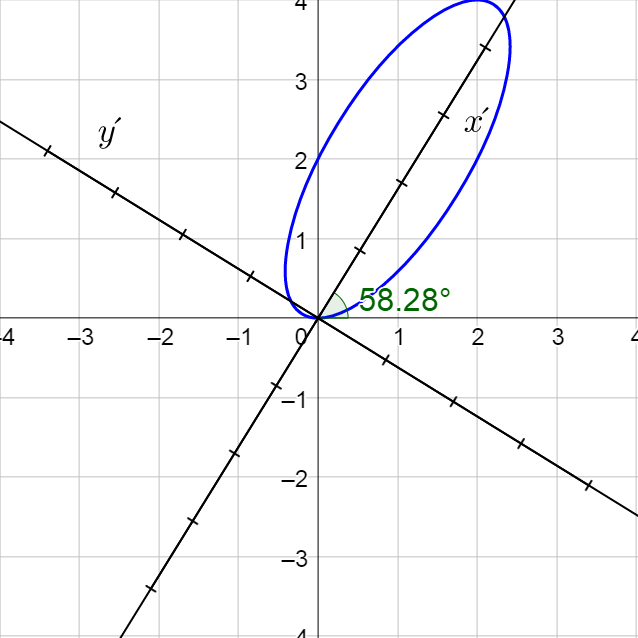
Classify the graph using the discriminant. B2 – 4AC = (−4)2 – 4(4)(1) = 0, so it is a parabola.
To solve for y, rearrange the terms in powers of y and factor.
4x2 − 4xy + y2 − x + y = 0
y2 + (−4xy + y2) + (4x2 − x) = 0
y2 + (−4x + 1)y + (4x2 − x) = 0
Now fill in the quadratic formula: \(y = \frac{-b ± \sqrt{b^2 - 4ac}}{2a}\).
$$y = \frac{-(-4x + 1) ± \sqrt{(-4x + 1)^2 - 4(1)(4x^2 - x)}}{2(1)}$$
Because of the ± sign, you will have to input two equations, one with + and one with −, to make the graph. Notice that the graph is shifted and (0, 0) is not the vertex.
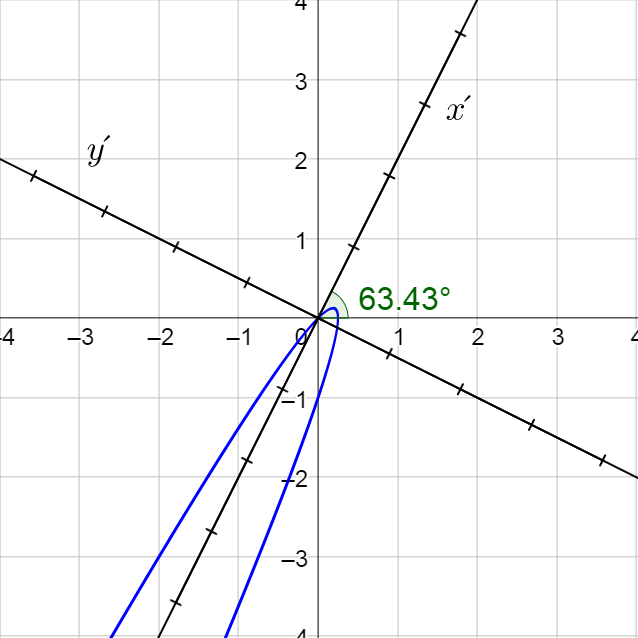
Classify the conic and graph it on a graphing utility.
Answers
(a) Hyperbola; 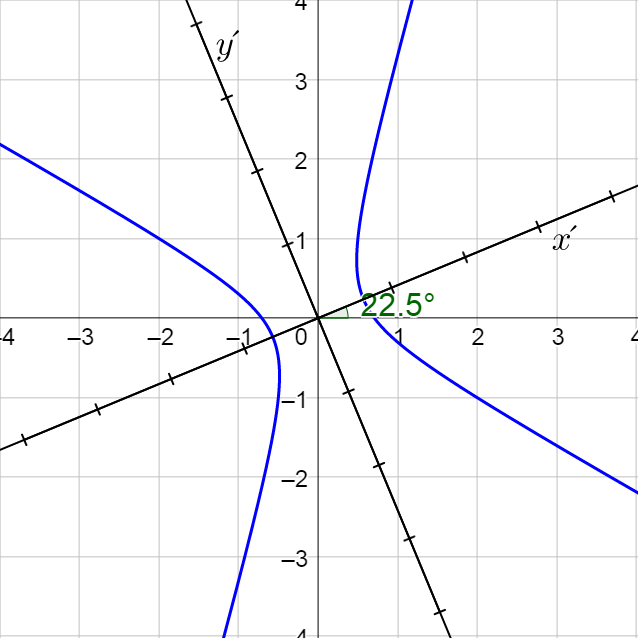 (b) Parabola;
(b) Parabola; 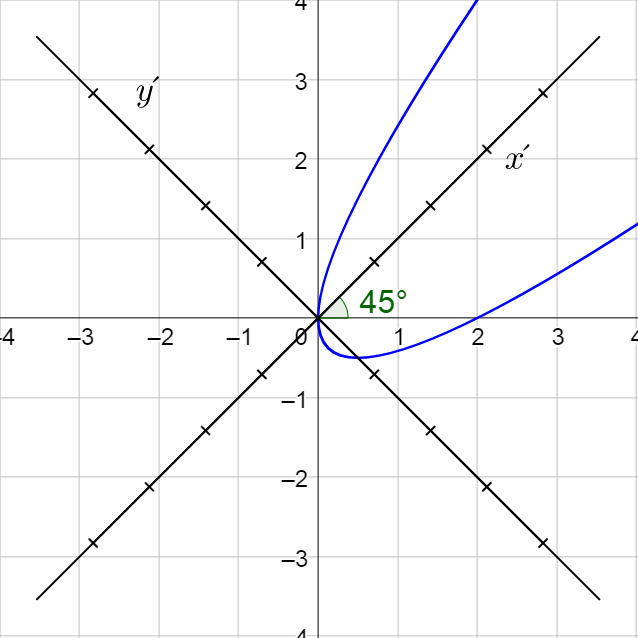
If the conic is in the form Ax2 + Bxy + Cy2 + Dx + Ey + F = 0 and B ≠ 0, then conic can be classified by
Given a conic written as Ax2 + Bxy + Cy2 + Dx + Ey + F = 0 where B ≠ 0
Find the angle of rotation using
$$\cot 2θ = \frac{A - C}{B}$$
where 0 < θ < \(\frac{π}{2}\).
Find sin θ and cos θ.
If θ is a special angle, evaluate sin θ and cos θ directly.
If θ is not a special angle,
Use the half-angle formulas to find sin θ and cos θ.
$$\sin θ = \sqrt{\frac{1 - \cos 2θ}{2}} \text{ and } \cos θ = \sqrt{\frac{1 + \cos 2θ}{2}}$$
Find the substitutions for x and y using
$$\begin{alignat}{2}x &= x′ \cos θ &&- y′ \sin θ\\y &= x′ \sin θ &&+ y′ \cos θ\end{alignat}$$
Helpful videos about this lesson.
